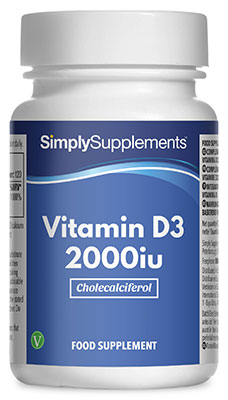Health Benefits of Vitamin D

Vitamin D is often known as the “sunshine vitamin” because the body produces it from the sun. Vitamin D is known to play a vital role in the development and maintenance of bones, and also supports both the immune system and mood.
The Department of Health has identified several population groups as ‘at-risk’ of low vitamin D levels, including young children, pregnant women, adults over the age of 65, and adults with little sun exposure. It also recommends that we all supplement with vitamin D during the winter months, when levels of sunlight are insufficient for the production of healthy vitamin D levels.
What is Vitamin D?
Vitamin D is different from other vitamins because the human body has the ability to produce it on its own – it is produced under the skin from direct exposure to sunlight. This essential vitamin has two main functions in the body; to support the absorption of calcium and phosphorous into our bones, and to manage the communication between cells.
Five different types of vitamin D have been identified; D1, D2, D3, D4 and D5. However, only D2 and D3 appear to be beneficial for humans.
Vitamin D2 (ergocalciferol): This type of vitamin D is naturally found in plants and is chemically very similar to D3 produced in humans. It has been used to successfully treat rickets for many years.
Vitamin D3 (cholecalciferol): D3 is naturally produced by the human body and so is the most natural form of vitamin D.
Both D2 and D3 are beneficial when taken as supplements and are equally as effective in the bloodstream. However, there is some evidence to suggest that when taken at high doses (around 1000iu and above) vitamin D3 may be more effective.
Benefits of Vitamin D
 Scientific studies have identified a number of important health benefits to getting enough vitamin D. Some of the most important of these are:
Scientific studies have identified a number of important health benefits to getting enough vitamin D. Some of the most important of these are:
Bone Health
Vitamin D has a well-established role in maintaining normal calcium levels and the growth and maintenance of strong bones and teeth. It can also help to reduce the risk of bone-weakening diseases such as osteoporosis, however the optimum supplement dosage still needs to be determined.
Immune System
Vitamin D is an immune system regulator that helps to fight infections such as colds and flu. It does this by attacking and destroying damaging bacteria and viruses. Study findings suggest that low vitamin D levels significantly increase the risk of flu.
Disease
It is thought that vitamin D may help to protect people at a genetic level to fight chronic diseases such as heart disease, bone weakening diseases, and diabetes.
Heart Function
Research suggests that there is a link between low vitamin D levels and hypertension (high blood pressure). For example, a review in 2013 found that for each 10 ng/ml increase in vitamin D levels, the risk of hypertension reduced by 12%.
Sources of Vitamin D
The most effective way to get vitamin D is through exposure to sunlight; 15 minutes of sunshine 3 to 4 times per week (without sunscreen) is sufficient for most people to maintain normal vitamin D levels, particularly during the summer months. However, there are certain factors which can reduce our exposure to vitamin D, some of which are outside of our control:
- Distance from the equator: the further you live from the equator, the weaker the sun’s rays and ability to trigger vitamin D synthesis. Plus, during many months of the year, the sun is simply not strong enough for our skin to synthesise any vitamin D.
- Cloud cover and pollution.
- Use of sunscreens.
 The body synthesises what it needs from the sun, so you cannot overdose on this source of vitamin D. However, always be careful when exposing the skin to sunlight as too much sun can be extremely bad for your health.
The body synthesises what it needs from the sun, so you cannot overdose on this source of vitamin D. However, always be careful when exposing the skin to sunlight as too much sun can be extremely bad for your health.
Natural food sources of vitamin D are limited, but some of the best options are cod liver oil, beef liver and egg yolks. There are also fortified foods, such as cereals, bread and margarine spreads. Many people choose to top up their diet with vitamin D supplements, which are widely available as both D2 and D3. Vitamin D supplements have been shown to improve the body’s vitamin D levels and support bone health, and are particularly important if you are in one of the at-risk groups.
Vitamin D Deficiencies
In the UK, you won’t make much vitamin D during the winter months due to the distance from the equator and the strength of the sun’s rays. From mid-October to the beginning of April there is no ambient ultraviolet sunlight of the appropriate wavelength [Source: NICE] so the body relies on vitamin D stores acquired during the summer months and dietary sources to maintain healthy vitamin D status.
If your vitamin D levels are low in the autumn months, it is unlikely any remaining vitamin D stores will last through the winter, which can result in low vitamin D status or even deficiency.
The Department of Health has identified the following groups as particularly ‘at-risk’ of vitamin D deficiency:
- Pregnant and breastfeeding women. During pregnancy, the foetus relies solely on the mother’s vitamin D levels. Breast milk is a poor source of vitamin D
- Babies and children under the age of five
- Adults over the age of 65. The skin becomes less efficient at synthesising vitamin D from the sun, and the kidneys are less able to convert the vitamin into its active form
- People with limited exposure to sunlight
- People who have darker skin such as people of African, African-Caribbean and South Asian origin, because the skin is less able to convert vitamin D from the sun
There is also evidence to suggest a link between increasing body mass index (BMI) and falling vitamin D levels. It is thought that vitamin D can become trapped inside fat tissues and so is unable to circulate in the blood.
Effects of Vitamin D Deficiency
In children, a vitamin D deficiency results in rickets, a condition which affects the formation and growth of bones. In severe cases bones become soft and malformed, and vulnerable to fractures and breaks.
In the UK, the number of cases of rickets has quadrupled over the past fifteen years, which experts attribute to several contributing factors; children are spending more time playing indoors which limits their exposure to sunlight; the rising use of sunscreen which reduce the body’s ability to synthesise vitamin D from the sun; and poor diets. It is estimated that between 8 and 24% of children in the UK have low vitamin D level depending on the time of year - reaches the higher end during the winter months.
In adults, vitamin D deficiency is referred to as osteomalacia, which again, causes soft and fragile bones. Many adults also experience pain in their bones and muscle weakness. Vitamin D deficiency has also been linked to several other health conditions in adults and is thought to increase the risk of heart disease, diabetes, certain cancers, osteoporosis and other bone-weakening diseases. The most recent large-scale survey released by NICE in 2014 found that 1 in 5 adults in the UK - around 10 million people - have low vitamin D levels and are at risk of complications from vitamin D deficiency.
During the winter months, nearly 75% of adults from Asian or African and Caribbean backgrounds have low vitamin D levels. The researchers involved in the survey advised that the current Nutrient Reference Values (NRVs) need to be reviewed.
Fortunately, many of the effects of vitamin D deficiency are reversible over time. Increasing your vitamin D intake will gradually improve bone density and strength. If severe, your doctor may prescribe high intermittent doses until vitamin D status reaches a normal range.
How Much Vitamin D Should I Take?
 Your dietary needs vary depending on your age, ethnicity, and exposure to sunlight. There is an ongoing dispute regarding the optimum levels of vitamin D and many experts are convinced the government’s recommended intakes are well below the level your body actually needs. In the UK, the Department of Health advises healthy adults with normal vitamin D levels to get 200 iu of vitamin D on a daily basis.
Your dietary needs vary depending on your age, ethnicity, and exposure to sunlight. There is an ongoing dispute regarding the optimum levels of vitamin D and many experts are convinced the government’s recommended intakes are well below the level your body actually needs. In the UK, the Department of Health advises healthy adults with normal vitamin D levels to get 200 iu of vitamin D on a daily basis.
The Department of Health recommends:
- Pregnant and breastfeeding women take 10mcg (400iu) daily
- Babies and children under 5 years take 7 to 8.5mcg daily
- Adults over 65 years take 10mcg (400iu) daily
- Adults with limited exposure to sunshine take 10mcg (400iu) daily
There is no official intake guideline for preventing osteoporosis and fractures, but most experts advise between 400iu -1000iu daily, while some suggest doses up to 2000iu may be warranted.
You are advised not to take more than 50mcg (2000iu) per day unless under the instruction of a healthcare professional.
Side Effects of Vitamin D
Vitamin D toxicity is extremely rare unless taken in super-high doses (higher than 4000iu daily for three months or more). Doses of this strength should only be taken under the guidance of a healthcare professional. If toxicity occurs, it can result in chronic hyperkalaemia, weakness, fatigue or headaches.
If you suffer from kidney disease and as a result have high levels of calcium in the blood, it is possible that supplementation with vitamin D could worsen symptoms. Speak to your GP prior to taking supplements.
Vitamin D supplements are safe to take during pregnancy and lactation. The foetus and baby are dependent on their mother’s vitamin D levels, and so pregnant women are advised to increase their intake to 600iu daily to support the growth of the foetus.
Shop for Vitamin D Supplements here.

Sources:
http://circ.ahajournals.org/content/117/4/503.short
http://hyper.ahajournals.org/content/51/4/1073.short
http://pediatrics.aappublications.org/content/124/3/e371.short
https://www.nature.com/nrcardio/journal/v6/n10/abs/nrcardio.2009.135.html
http://www.sciencedirect.com/science/article/pii/S1471489210000378
http://jim.bmj.com/content/59/6/881?trendmd-shared=0&utm_campaign=DE_JP_NL&utm_medium=TrendMD&utm_source=TrendMD_JIM
http://journals.lww.com/co-nephrolhypertens/Abstract/2008/07000/Vitamin_D_and_the_immune_system__role_in.3.aspx
http://cjasn.asnjournals.org/content/3/5/1548.short

 Nicole
Nicole 

























